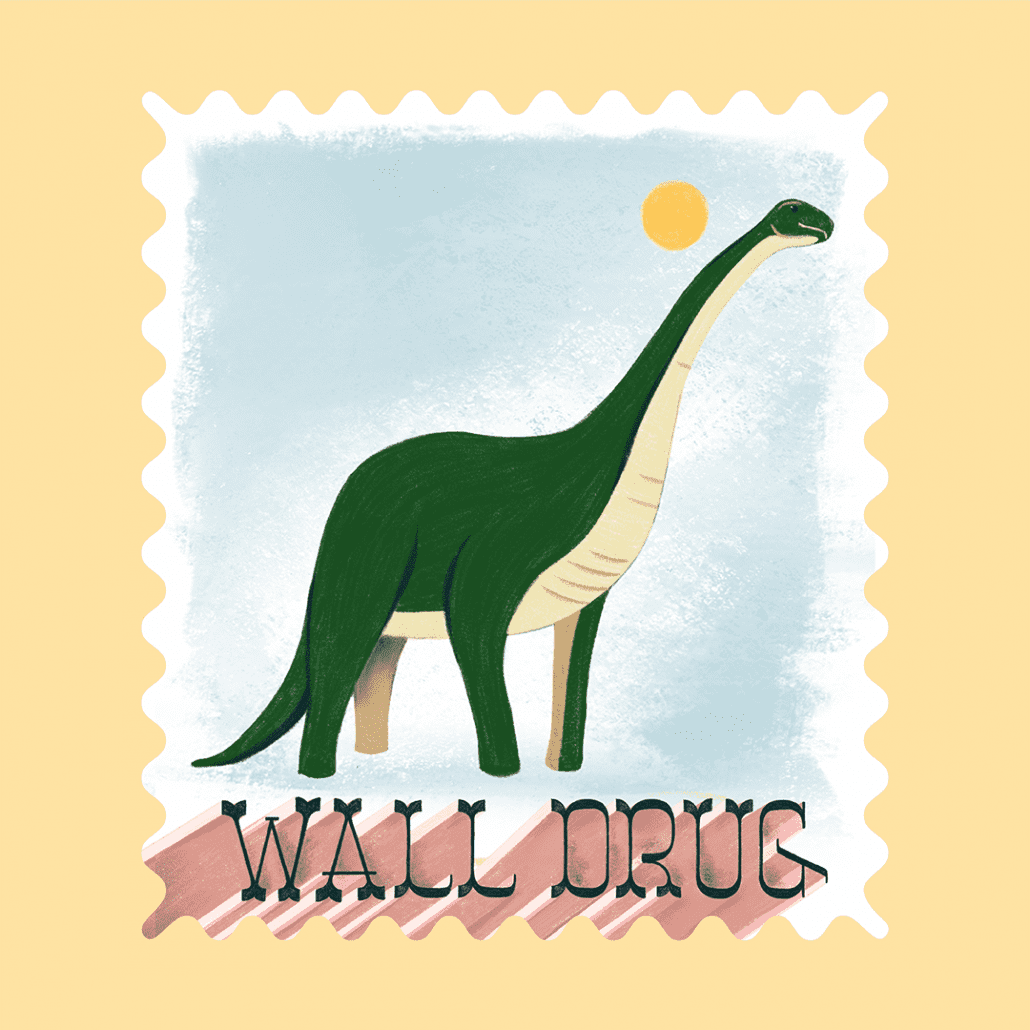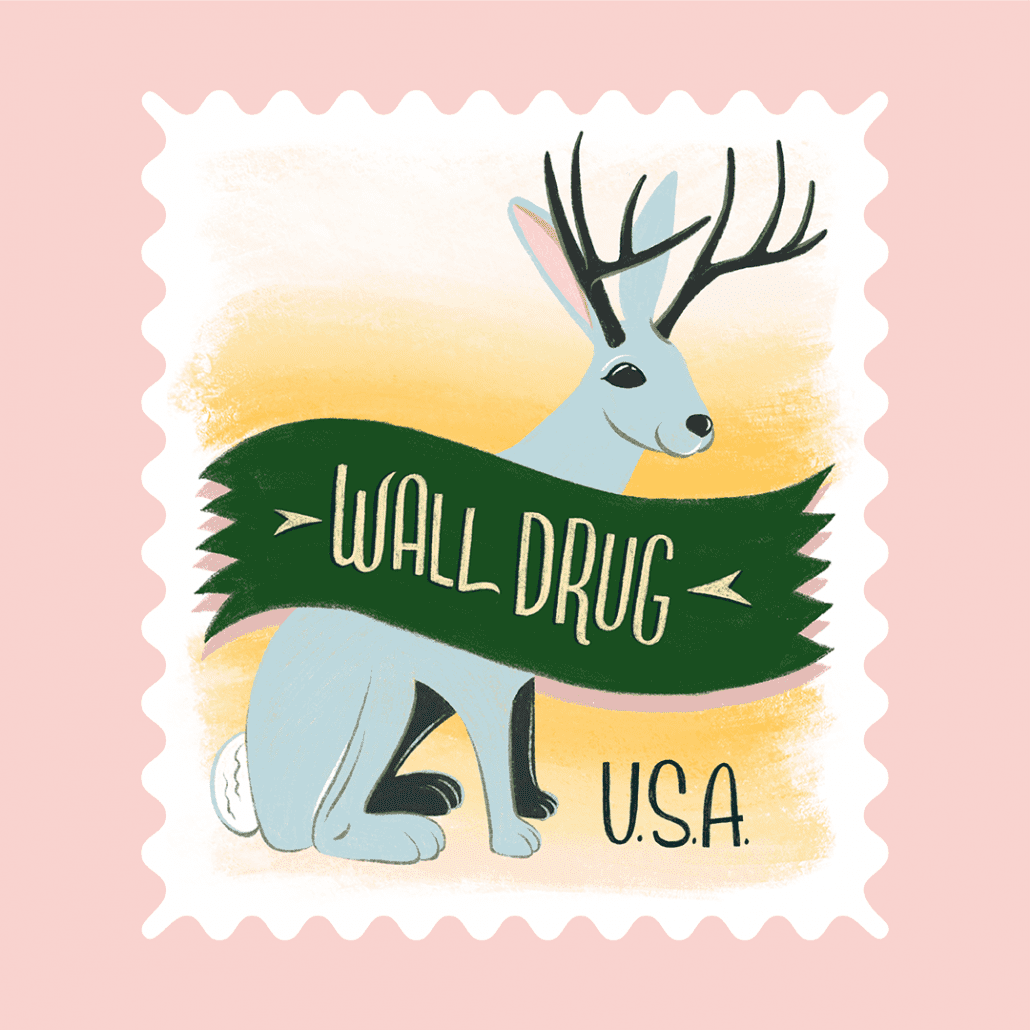MJM Designers Participate in AIGA South Dakota Stamp Show
Earlier this month, we had the opportunity to participate in a group show created by AIGA South Dakota — the South Dakota Stamp Show. For this show, AIGA asked 13 area designers to each create a set of five concept postage stamps around a topic related to our fair state. There was a lot of good work in this show, and you can still see it at the Sioux Falls Design Center for a limited time.
Here the designers at MJM talk about their process and work:
Deadwood
Deadwood is deceiving town.If you were to visit the area today, it presents itself as an unassuming South Dakota town and (aside from some gambling and historic displays) you wouldn’t guess its rich history. With this topic, I saw an opportunity to highlight the people from a long-gone era that made Deadwood a household name. People like Poker Alice and Wyatt Earp. As I researched these historic individuals, I found myself thinking of them as more characters in a drama and less actual people that lived out their lives in our rural region. With names like Wild Bill and Calamity Jane, it’s difficult not to. Because of this, I chose to make the goal of this stamp series is to spotlight that juxtaposition of real person and western legend with a set of minimalist caricatures of some of the most famous people to reside in Deadwood.
Roadside Attractions
South Dakota has mastered the art of the roadside attraction. Drive down any highway in the state and you’ll be bombarded with billboards advertising sites ranging from the delightfully kitschy to the straight-up bizarre. Are they desperate money grabs? Maybe. But you have to admire the ingenuity of people who have found a way to use whatever resources they have at their disposal to capture people’s attention. The kind of ingenuity that sees some old pieces of wood and turns them into a forest or sees an abandoned town and fills it with animatronic cowboys. Because, why not? In a state as vast and unpopulated as South Dakota, it takes a little bit more effort to remind people that you exist. To honor these beacons of the prairie, I wanted to design stamps that were, above all, fun. South Dakota is usually expressed in shades of greens and browns and I wanted to bring in some vivid technicolor that screams, “I’m here! Look at me!”
I-90
Interstate 90 runs through the center of the state and is the main artery of travel for most people moving through South Dakota. I-90 unifies the state, and touches on a lot of common elements of the experience of living here.
Bisontennial: 200 years ago there were an estimated 75 million bison roaming the countryside. By 1895, that number was cut to 800 due to reckless and wasteful hunting. Now, after 200 years, the North American bison is again thriving in commercial herds and roaming in both wild and protected places. The population is now estimated to be about 500,000.
Accumulation: In a state that averages between 30 to 70 inches of annual snowfall, snow (and snow removal) is a large feature of life. For every mile of interstate, South Dakota spends more than $2,800 on winter maintenance. So if you get a chance, buy a coffee for one of the 400 or so workers who are driving the state DOT’s snowplows this year.
No Services: With the straight lines created by the 1956 Interstate Highway Act, small towns that found themselves too far off the interstate gradually lost ground to those communities that were closer. Sometimes towns bypassed by the interstate saw business come to a standstill literally overnight.
Home Alone: My first car was a 1984 Subaru GL station wagon, light blue and relatively reliable. I loved that I could throw everything I needed in the back and drive wherever I needed to go. I put Christmas lights in the back windows and installed a switch by the gear shift—I’m lucky the whole thing didn’t catch on fire. My second car was a 1990 Subaru Legacy station wagon—no Christmas lights but just as great. I’ve never owned a kayak or a teardrop trailer, but maybe someday.
Share the Road: Of the 546 motorcycle accidents reported last year, 51% involved another motor vehicle. And I drew a helmet on this guy because in 245 (or 55%) of last year’s accidents the riders weren’t wearing helmets.
South Dakota Rocks!
Rock climbing strikes me as a very physical test of strength and endurance, but also one of creativity—finding a route up what appears at first to be an unscalable rock face. So it’s only appropriate that one must also exercise creativity in naming a newly devised route—an honor given to the first climber to ascend (or “send” in climbing lingo) a new route. South Dakota’s Black Hills region features granite spires and limestone canyons that provide for spectacular rock climbing, and which give birth to even more spectacular names.
In rock climbing there are both good and bad names. Poor names are childish or in poor taste; the worst names are misogynistic or racist. A good name can put a new climb on the map, attracting more climbers and elevating it to the status of legendary. The best names describe the rock or route itself with fitting imagery or a clever reference. In that sense it can be like the task of naming a new business, or designing an appropriate logo for it. Cerberus, a climb in Custer State Park, is on a spire with three little peaks at the top—a reference to the three-headed hound that guards the gates of the underworld in Greek mythology. The name lends enough antagonism to feel like a challenge or foe to overcome, inviting intrepid climbers to try and best the beast.
Wall Drug
Wall Drug is a wonderfully weird place. It’s the ultimate American road trip stop attracting 2 million people* per year—but why is it so popular? I think some people just need to see what all the fuss is about. Hand-painted billboards advertising Free Ice Water put Wall Drug on the map decades ago and led to a national and international network of billboards that point back to this obscure corner of South Dakota. The climbable jackalope, the 80-foot dinosaur, homemade donuts, and iconic signage are the most popular tourist photos at Wall Drug. I drew them with a brush tool that gives it some roughness reminiscent of a fading billboard. The pastel color palette borrows from that early-morning light and shadowy landscape you get on a long road trip. I, the bleary-eyed kid in the back seat of this road trip, wakes up and thinks, “Where in the world are we?” We pull up to a parking space. The sign says “Welcome to Wall Drug” and it smells like donuts.
*To put it this number into perspective, there are less than 1 million people living in both North and South Dakota combined.
Kirstie is a Senior Designer and Web Lead at Matt Jensen Marketing.































